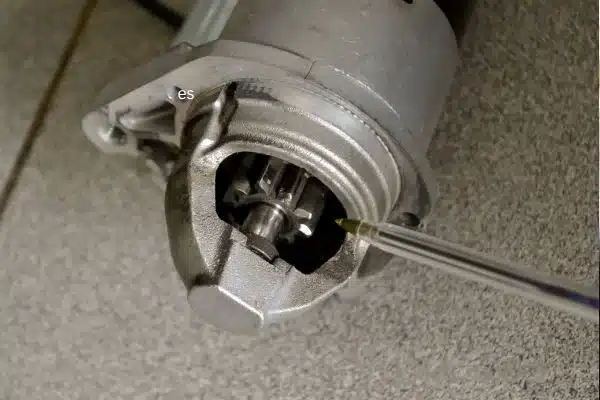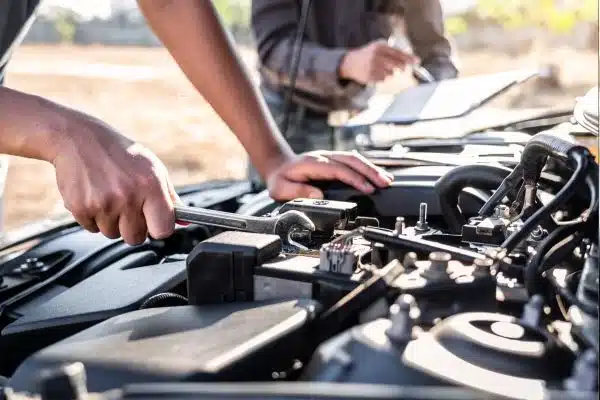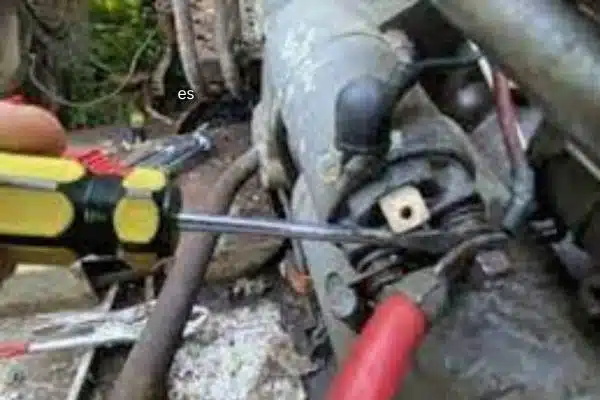Knowing how to jump a starter solenoid with a screwdriver can be valuable in emergencies. The starter solenoid plays a crucial role in starting a vehicle; if it malfunctions, the engine may fail to turn over. This step-by-step guide provides instructions to safely jump a starter solenoid using a screwdriver.
Locate the solenoid near the battery. Ensure the engine turns off and the transmission is in park or neutral. Identify the “S” and “B” terminals on the solenoid. Grab an insulated screwdriver and touch the tip to the “B” terminal, carefully avoiding contact with metal or the engine block. Then, bridge the screwdriver from the “B” terminal to the “S” terminal. This connection bypasses the solenoid, allowing electricity to flow directly to the starter motor.
By following these procedures and taking proper safety precautions, you can confidently tackle this task when faced with a faulty solenoid. So, let’s move into the details and learn how to jump a starter solenoid quickly and efficiently.
What is a Starter Solenoid?
It’s a small electrical component that bridges the vehicle’s battery and the starter motor. The starter motor turns the engine on when a signal is sent to the solenoid.
“A starter solenoid is an essential component in an automotive starting system. It serves as a high-current switch that transmits electrical power from the vehicle’s battery to the starter motor.” When the ignition key is turned, a small current is sent to the solenoid, which then engages an electromagnet. This action pulls a plunger or lever, completing the circuit between the battery and the starter motor, allowing it to spin and crank the engine.
Once the engine is running, the solenoid disengages, interrupting the current flow and preventing damage to the starter. Essentially, the starter solenoid plays a crucial role in initiating the engine’s operation by efficiently managing the high electrical currents required for the starting process.
Where is the Starter Solenoid Located?
It depends on the make and model of the vehicle where the starter solenoid is, and it also varies from model to model. This sensor is usually mounted on the starter motor in engine compartment. To access the starter solenoid you must have to remove the engine cover first.

How To Locate The Starter Solenoid In Your Car?
Before you can jump a starter solenoid, you need to locate its position in your vehicle. Your car’s model and make may determine where it is. The following guidelines will help you find the starter solenoid:
Consult the Vehicle Manual
Please refer to your vehicle’s manual for specific information about the starter solenoid location. Identifying its place will be more straightforward with the manual’s detailed instructions and diagrams.
Look in the Engine Compartment

The starter solenoid is typically found in many vehicles in the engine compartment. Start by visually inspecting the area near the battery, the starter motor, or along the fender well. Look for a small cylindrical or rectangular-shaped component with electrical connections.
Follow the Wires
If you’re having difficulty locating the solenoid visually, trace the wires from the battery to the starter motor. The solenoid is usually positioned along this path, typically mounted on or near the starter motor assembly.
Identify the Solenoid Terminal
Identifying the correct solenoid terminal to jump a starter solenoid with a screwdriver. Here’s how you can locate it:
Examine the Solenoid
Carefully inspect the starter solenoid to locate the terminals. You’ll typically find two large terminals connected to the solenoid and smaller control wires.
Locate the Battery Terminal
Identify the terminal that is directly connected to the vehicle’s battery. This terminal usually has a “+” or a positive sign. It receives power from the battery to engage the solenoid and start the vehicle.
Locate the Starter Terminal
The other terminal is connected to the starter motor. This is the terminal you need to jump with a screwdriver to activate the solenoid and engage the starter motor. It is often labeled with an “S” or “ST.”
Read more aboutHow to discharge a capacitor with a screwdriver
7 Common Symptoms of a Faulty Starter Solenoid
When the starter solenoid begins to fail, you might experience several warning signs. These can include a clicking sound when you turn the key, the engine not starting despite a fully charged battery, or intermittent starting issues. Recognizing these symptoms can help you determine if a faulty solenoid is the root cause of your vehicle’s starting problem.
Clicking Sound When Turning the Key: If your starter solenoid is bad, you will hear a rapid clicking noise when you turn the ignition key. In this case, the solenoid is struggling to engage the motor.
No Cranking Noise: When you turn the key, there may be no cranking noise due to a faulty starter solenoid. Consequently, it isn’t triggering the engine’s cranking process by supplying power to the starter motor.
Intermittent Starting Issues: Starting problems may occur intermittently due to a faulty solenoid. If the engine starts one time but fails to start on the next attempt, you may encounter this problem.
Starter Stays Engaged: When a solenoid malfunctions, the starter can remain engaged even after the engine has started. Flywheels and starter motors can be damaged in this way.
Dimming Lights: When you try to start the vehicle, the dashboard lights and headlights may dim significantly. When the starter solenoid draws too much current, this can be a sign that it is overheating.
Burning Smell: An electrical issue could cause the solenoid to overheat, especially around the starter area. In order to prevent further damage, this should be addressed as soon as possible.
Starter Fails to Disengage: If the starter keeps running after the engine has started, there is a problem with the solenoid. As a result, both the starter and flywheel can suffer severe damage.
Take Safety Precautions
Jumping a starter solenoid with a screwdriver involves working with electrical components and potential hazards. To ensure your safety throughout the process, follow these necessary safety precautions:
Disconnect the Vehicle’s Battery: Before attempting any work on the starter solenoid, disconnect the negative terminal of the vehicle’s battery. This step is crucial to prevent accidental electrical contact or short circuits while working on the solenoid.
Work in a Well-Ventilated Area: Ensure you’re in a well-ventilated or open space to avoid inhaling harmful gases. This precaution is essential if you’re working on an old car or one with a potential exhaust leak.
How to jump a starter solenoid with a screwdriver? Learn just 4 Steps
Having prepared the screwdriver and identified the solenoid terminal, it is time to jump the starter solenoid. Here are the steps
You’ll need a few essential tools to successfully jump a starter solenoid with a screwdriver.
- Screwdriver
- Safety Goggles and Gloves
Read more about How to test starter solenoid with multimeter
Step02 | Position the Screwdriver
Hold the screwdriver firmly with your hand. Place the screwdriver’s tip on the solenoid terminal on the starter motor. Make sure the screwdriver is making good contact.
Step03 | Create a Connection
Connect the other end of the screwdriver shaft to the battery’s positive terminal. Simulates the ignition switch’s signal by temporarily connecting the battery and solenoid terminal.
Step04 | Be Mindful of Sparks
As you make the connection, be prepared for tiny sparks to occur. These sparks are expected due to the electrical current flowing through the circuit. However, ensure the screwdriver does not touch any other metal parts of the vehicle to avoid unintended consequences.
Step05 | Jump the Solenoid Quickly

Once the connection is made, quickly remove the screwdriver from the solenoid terminal. This should activate the solenoid, engaging the starter motor and initiating the engine’s rotation. Remember to remove the screwdriver swiftly to prevent any prolonged contact that could damage the solenoid or other components.
How to Test the Solenoid?
Testing its functionality is essential after knowing how to jump a starter solenoid with a screwdriver. Follow these steps to ensure that the solenoid is working correctly:
Read more about How to test lawn Mower starter with multimeter
Listen for Starter Motor Engagement
After you jump the solenoid, listen for any sounds that indicate the starter motor is working. Starter motors usually make a clicking or whirring noise when the solenoid is activated.
Observe the Engine’s Response
Pay attention to how the engine responds. The solenoid works when the engine starts and runs smoothly. You should carefully observe the engine’s response.
Note any Issues or Abnormalities
If the engine fails to start or exhibits irregular behavior, other underlying issues may exist apart from the solenoid. Note any specific symptoms or abnormalities you observe during the testing process.
Reassemble and Test
After successfully jumping the starter solenoid and confirming its functionality, it’s essential to reassemble any separate components and perform a final test. Follow these steps to complete the process:
Reassemble Disconnected Components
If you had to remove any components or wires during the jumping process, ensure that you reassemble them correctly. Connect any control wires or cables disconnected earlier, ensuring they are securely attached.
Reconnect the Vehicle’s Battery
Carefully reconnect the negative terminal of the vehicle’s battery. Double-check that it is adequately secured and tightened to ensure a reliable electrical connection.
Perform a Test Start
With everything reassembled, it’s time to perform a final test start. Turn the ignition key and observe the engine’s response. If the engine starts smoothly and runs without issues, the starter solenoid works correctly, and your vehicle is ready.
Note any Lingering Issues.
When you have lingering problems, like the engine not starting or abnormal behavior, it could mean something else wrong. You should consult a mechanic or automotive professional to diagnose and fix such issues.
FAQs about how to jump a starter solenoid with a screwdriver
How do you start a car with a bad starter solenoid?
If you’re dealing with a bad starter solenoid in your car, don’t worry, there’s still a way to get your engine running! Here’s a simple workaround that can help you get going:
Manual Bypass Method
Step #1
Locate the starter motor under your vehicle. It’s usually situated near the engine, underneath the car. Following the steps can help to start a car with a bad starter solenoid.
Step #2
Use a long, insulated screwdriver or a piece of sturdy wire to bridge the gap between the car battery’s positive terminal and the starter motor’s solenoid terminal.
Step #3
With the car in neutral and the parking brake engaged, insert the screwdriver or wire into the solenoid terminal while keeping a firm grip on the insulated handle.
Step #4
Apply pressure and simultaneously turn the ignition key to the “Start” position. This should create a connection and allow the electrical current to reach the starter motor, initiating the engine’s cranking action.
Can I tap my starter to make it work?
Tapping the starter can sometimes be a temporary solution to get it working. Give it a gentle tap with a solid object like a small hammer or wrench. The idea is to dislodge any potential debris or loosen stuck parts inside. However, it’s important to remember that this is a quick fix, not a long-term solution. If tapping the starter works, having it inspected and repaired by a professional mechanic is still crucial.
They can identify the underlying cause of the issue and provide a more permanent fix. Don’t rely solely on tapping, as it may only solve the problem partially. Your vehicle’s safety and reliability are paramount, so it’s best to address any starting issues promptly and correctly.
What are the two leading causes of solenoid failure?
Electrical issues can occur due to excessive heat, high current flow, or voltage spikes, which can damage the solenoid’s internal wiring or coil. Mechanical problems, on the other hand, can result from worn-out components, such as a worn plunger or damaged contacts, preventing the solenoid from functioning correctly.
Regular maintenance and timely repairs can help avoid these causes of solenoid failure, ensuring the smooth operation of your vehicle’s starting system. If you suspect solenoid failure, it’s best to have it diagnosed and repaired by a qualified mechanic to address the root cause effectively.
Conclusion
Knowing how to jump a starter solenoid with a screwdriver when your car doesn’t start is helpful. Be safe, know your starter solenoid, and get the right tools. Locate the solenoid, identify the correct terminal, and prepare the screwdriver.
By following the instructions, testing the solenoid, and reassembling any separate parts, you can get your vehicle on the road again. Getting help if you have any problems is always a good idea. When you handle starter solenoid problems safely, your vehicle will run smoothly again.

